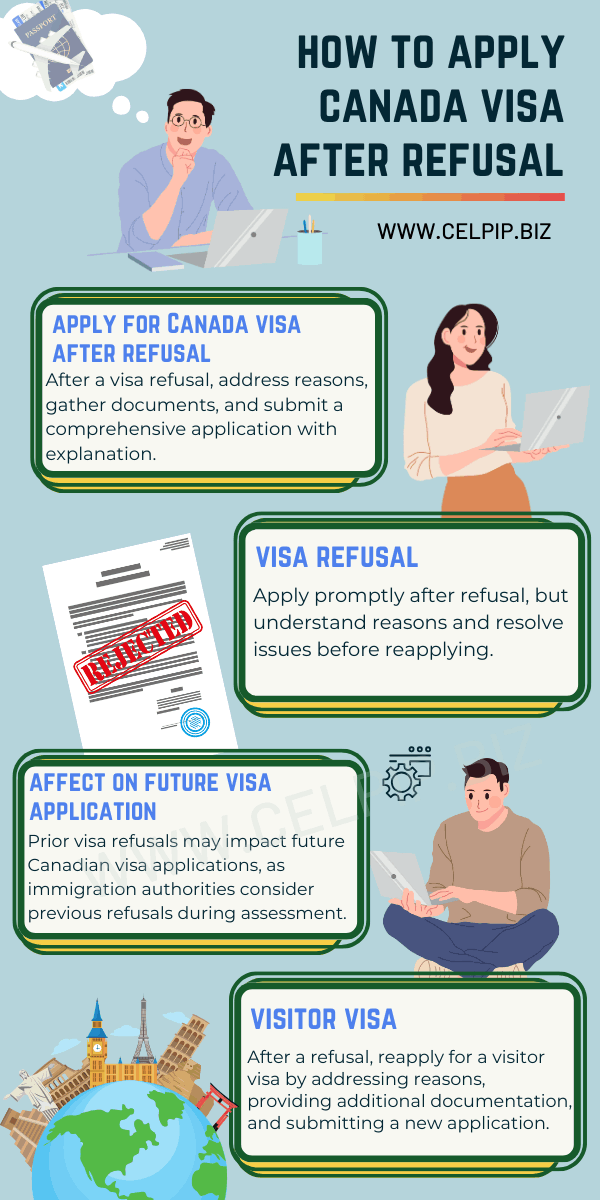The plan to visit or relocate to Canada, definitely you need to apply for Canada Visa, which is often filled with excitement and anticipation. However, for many hopeful applicants, the process presents unexpected hurdles, particularly when faced with a visa refusal.
While receiving a visa refusal can be disheartening, it’s essential to understand that it’s not the end of the road. In this article, we delve into the intricate process of applying for a Canada visa after experiencing a refusal.
From understanding the reasons behind the refusal to strategizing and presenting a stronger application, we aim to equip you with the knowledge and resources necessary to navigate this challenging terrain.
Whether you’re seeking temporary residency, permanent immigration, or simply wish to explore the vast opportunities Canada has to offer, we’re here to guide you through the steps to enhance your chances of a successful visa application.
Let’s embark on this journey together, turning setbacks into stepping stones toward your Canadian dream.
Common Reasons Behind Canada Visa Refusal
It’s crucial for applicants to thoroughly review the visa requirements and guidelines provided by the Canadian immigration authorities, ensure all documentation is complete and accurate, and address any concerns or potential red flags in their application to maximize their chances of approval.
Here are some common reasons why a Canada visa application might be refused:
- Incomplete or Inaccurate Documentation – One of the most prevalent reasons for visa refusal is incomplete or inaccurate documentation. This could include missing forms, unsigned applications, or failure to provide required supporting documents such as financial statements, travel itineraries, or letters of invitation.
- Insufficient Financial Resources – Canada immigration authorities require applicants to demonstrate that they have enough funds to support themselves during their stay in Canada. If the applicant fails to provide convincing evidence of their financial stability, the visa may be refused.
- Inadmissibility – Applicants may be deemed inadmissible to Canada for various reasons, including criminal history, security concerns, or medical issues. Even minor criminal offenses or health conditions that may pose a risk to public health could result in visa refusal.
- Lack of Ties to Home Country – Immigration officers assess whether applicants have strong ties to their home country to ensure they will return after their visit to Canada. Lack of ties, such as stable employment, property ownership, family connections, or community involvement, could raise concerns about the applicant’s intention to leave Canada at the end of their authorized stay.
- Purpose of Visit Not Clearly Stated – Applicants must clearly state the purpose of their visit to Canada and provide supporting documentation to substantiate their intentions. Vague or unclear reasons for travel may lead to suspicion or doubt regarding the applicant’s true motives, resulting in visa refusal.
- Failure to Meet Health and Security Requirements – Applicants must meet Canada’s health and security requirements to be granted a visa. This includes undergoing medical examinations, providing police clearance certificates, and disclosing any relevant information about previous criminal activity or security risks.
- Misrepresentation or Fraud – Providing false information or documents, withholding relevant information, or misrepresenting facts in the visa application can lead to immediate refusal and may result in a ban on future applications.
Tips to Strengthen Canada Visa Application
Here are some detailed tips to strengthen your Canada visa application:
- Thoroughly Understand the Requirements – Before you begin your application, carefully review the requirements for the specific visa category you are applying for. Each visa type has its own set of criteria and documentation requirements. Understanding these requirements will help you prepare a comprehensive and accurate application.
- Provide Clear and Accurate Information – Ensure that all information provided in your application is truthful, accurate, and consistent. Any discrepancies or inconsistencies could raise red flags and lead to visa refusal. Double-check all forms and documents for errors before submission.
- Submit Complete Documentation – Gather all required supporting documents and ensure that your application package is complete. This may include passports, photographs, financial statements, employment verification letters, travel itineraries, and any other relevant documents specified in the application guidelines. Submitting a thorough documentation package demonstrates your preparedness and sincerity.
- Address Previous Refusals (if applicable) – If you have previously been refused a visa to Canada, address the reasons for refusal in your new application. Provide additional documentation or explanations to mitigate any concerns raised in the previous refusal. This shows that you have taken proactive steps to address any issues and are genuinely committed to meeting the requirements.
- Demonstrate Strong Ties to Your Home Country – Immigration officers want to ensure that you will return to your home country after your visit to Canada. Provide evidence of strong ties to your home country, such as stable employment, property ownership, family relationships, or community involvement. This helps establish your credibility and reduces the risk of overstay.
- Articulate Your Purpose of Visit Clearly – Clearly state the purpose of your visit to Canada and provide supporting documentation to substantiate your intentions. Whether you are visiting for tourism, business, study, or family reasons, explain the purpose of your trip in detail and how it aligns with your personal or professional goals.
- Showcase Financial Stability – Provide evidence of sufficient funds to cover your expenses during your stay in Canada, including accommodation, transportation, and living expenses. This could include bank statements, income tax returns, employment verification letters, or sponsorship letters from a family member or friend in Canada.
- Seek Professional Assistance (if needed) – If you’re unsure about any aspect of the application process or have a complex case, consider seeking assistance from immigration consultants or legal professionals. They provide guidance, review your application, and offer valuable insights to strengthen your case.
- Submit a Well-Written Letter of Explanation – If there are any discrepancies or potential concerns in your application, consider submitting a letter of explanation to provide context or clarification. Be honest and concise in your explanation, addressing
any issues directly and providing supporting evidence where necessary.
- Plan Ahead and Apply Early – Start the application process well in advance of your planned travel date to allow ample time for processing and potential delays. Rushed applications are more likely to contain errors or omissions, which could jeopardize your chances of approval. Applying early also gives you time to address any additional requests or concerns from the immigration officer.

Steps to Reapply Canada Visa after Refusal
By following the below mentioned steps and taking proactive measures to address the reasons for refusal, you can increase your chances of a successful outcome and ultimately realize your dream of visiting Canada.
Here are the detailed steps to reapply for a Canada visa after a refusal:
- Review the Refusal Letter – Carefully review the refusal letter you received from the Canadian immigration authorities. Pay close attention to the reasons for refusal outlined in the letter, as this will guide your strategy for reapplication.
- Understand the Reasons for Refusal – Take the time to understand why your previous visa application was refused. Common reasons for refusal include incomplete documentation, insufficient funds, lack of ties to your home country, or concerns about the purpose of your visit. Understanding the specific reasons for refusal will help you address any weaknesses in your new application.
- Gather Additional Supporting Documents – Based on the reasons for refusal, gather any additional supporting documents or evidence that may strengthen your new application. This could include updated bank statements, employment verification letters, travel itineraries, letters of invitation, or any other relevant documentation requested by the immigration authorities.
- Address the Concerns Raised in the Refusal Letter – If the refusal letter highlights specific concerns or deficiencies in your previous application, take proactive steps to address these issues in your new application. Provide clear and convincing explanations, along with supporting evidence, to demonstrate that you have taken corrective action and are now fully compliant with the visa requirements.
- Update Your Application Forms – If there have been any changes to your personal or travel circumstances since your last application, ensure that you update your application forms accordingly. Provide accurate and up-to-date information to avoid any discrepancies or inconsistencies.
- Prepare a Comprehensive Letter of Explanation – Write a detailed letter of explanation to accompany your new application. Use this opportunity to address the reasons for refusal, provide context or clarification where needed, and articulate your genuine intentions for visiting Canada. Be honest, concise, and persuasive in your explanation, and provide supporting evidence where appropriate.
- Submit Your Application Package – Compile all required documents, including the updated application forms, supporting documentation, and letter of explanation, into a comprehensive application package. Ensure that your application is complete, accurate, and well-organized before submitting it to the Canadian visa office or visa application center.
- Follow Application Instructions Carefully – Pay close attention to the instructions provided by the Canadian immigration authorities regarding the submission of your application. This may include specific requirements for document format, payment of application fees, or submission deadlines. Failure to follow instructions could result in processing delays or further refusal.
- Monitor the Status of Your Application – After submitting your application, monitor the status of your application through the online tracking system provided by the Canadian immigration authorities. Be prepared to respond promptly to any requests for additional information or documentation from the visa office.
- Stay Positive and Patient – Reapplying for a Canada visa after a refusal is a challenging and stressful process. However, it’s important to stay positive, patient, and persistent throughout the process. Keep focused on your goal of visiting Canada, and remain proactive in addressing any concerns or obstacles that may arise during the reapplication process.
Conclusion
In conclusion, navigating the process of applying for a Canada visa after experiencing a refusal is certainly a daunting task, but it’s important to approach it with determination and a strategic mindset.
By understanding the reasons behind the refusal, addressing any deficiencies in your previous application, and presenting a stronger case in your reapplication, you significantly increase your chances of success.
Throughout this article, we’ve discussed various tips and strategies to help you strengthen your Canada visa application after a refusal.
From gathering comprehensive documentation to demonstrating strong ties to your home country and providing a clear and compelling explanation for your visit to Canada, each step plays a crucial role in enhancing your application.
It’s essential to approach the reapplication process with patience, persistence, and a positive attitude. Keep in mind that visa refusals are not uncommon, and they do not necessarily mean the end of your Canadian dream.
By learning from the feedback provided in the refusal letter, taking proactive steps to address any concerns, and submitting a well-prepared application package, you can maximize your chances of obtaining the visa and realizing your goal of visiting Canada.
In the end, success often lies in thorough preparation, attention to detail, and the willingness to adapt and improve. With determination and perseverance, you can overcome the challenges of a previous refusal and ultimately achieve your dream of exploring the beauty and opportunities that Canada has to offer.
Frequently Asked Questions (FAQs)
- How to apply for Canada visa after refusal?
To apply for a Canada visa after refusal, thoroughly review the reasons for refusal, address any deficiencies in your previous application, gather additional supporting documents, and submit a well-prepared application package with a detailed letter of explanation.
- Can I apply immediately after visa refusal?
Yes, you can apply immediately after a visa refusal, but it’s crucial to take the time to understand the reasons for refusal and address any issues before reapplying.
- Does visa refusal affect future visa application in Canada?
Yes, a visa refusal can potentially affect future visa applications in Canada, as immigration authorities may take previous refusals into consideration when assessing your eligibility for a visa.
- Can I reapply for visitor visa after refusal?
Yes, you can reapply for a visitor visa after a refusal by addressing the reasons for refusal, providing additional documentation or explanations, and submitting a new application package.
You may also know the detailed information on Updates on Canada Express Entry Program 2024.
Check out our Web Story at How to Apply Canada Visa after Refusal




